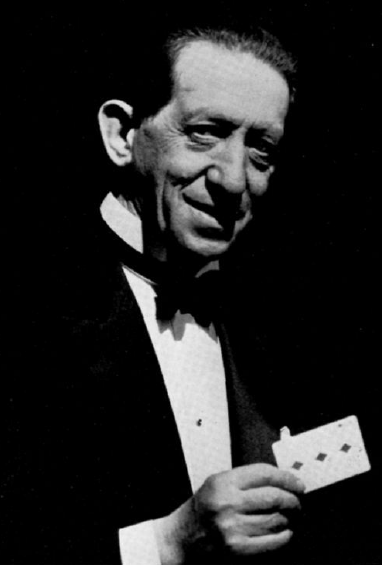Help us get to over 8,750 articles in 2024.
If you know of a magician not listed in MagicPedia, start a New Biography for them. Contact us at magicpediahelp@gmail.com
Difference between revisions of "Magicpedia:Today's featured article"
| Line 9: | Line 9: | ||
</noinclude> | </noinclude> | ||
| − | ''' | + | '''Nate Leipzig''' (1873-1939) was one of the early pioneers of performing simple straight forward magic with normal objects and passing on the use of fancy boxes and gadgetry. His work influenced people like [[Dai Vernon]], [[Roy Benson]], and [[John Scarne]]. He also created the [[Leipzig Pass]]. |
| − | + | ||
| − | [[ | + | |
| − | + | ||
| − | + | == Biography == | |
| + | [[File: NateLeipzig.png|right|thumb|200px|[[Nate Leipzig]]]] | ||
| + | In the late 1800's Nate Leipziger saw a magician at a child's party and wanted to learn more about magic. He learned his craft from books and had the belief that magicians were supposed to develop their own techniques. So rather than perform the effects he learned from magic books he developed his own methods. Because of this, Nate Leipzig was amazing both lay audiences as well as magicians. One of his early creations was the Coin Roll, where a coin rolls over the back of the fingers. Nate's original version however had the coin not only rolling over the backs of the fingers, but the hand would be turned over and the coin would continue to roll on the palm up fingers as well. | ||
| + | Around 1901 Nate left his job as an optician and went into a partnership with William and Felix Berol, who made rag pictures on a large easel. For a time he was known as "Nate Berol". This was not a magic act however and lasted for only two years. After this time, Nate got his own break into Vaudeville by filling in for magician [[Warren Keane]] at Proctors in New York. Audiences and agents were so impressed after his two days at Proctors that the famous agent William Morris arranged a tour for Nate to work the entire Keith Vaudeville Circuit. | ||
| − | [[ | + | [[Nate Leipzig|Read more about Nate Leipzig...]] |
Revision as of 21:37, 1 October 2023
Previous featured articles are located in Category:Featured Article
Proposed candidates are listed in Category:Featured Article Candidate
Nate Leipzig (1873-1939) was one of the early pioneers of performing simple straight forward magic with normal objects and passing on the use of fancy boxes and gadgetry. His work influenced people like Dai Vernon, Roy Benson, and John Scarne. He also created the Leipzig Pass.
Biography
In the late 1800's Nate Leipziger saw a magician at a child's party and wanted to learn more about magic. He learned his craft from books and had the belief that magicians were supposed to develop their own techniques. So rather than perform the effects he learned from magic books he developed his own methods. Because of this, Nate Leipzig was amazing both lay audiences as well as magicians. One of his early creations was the Coin Roll, where a coin rolls over the back of the fingers. Nate's original version however had the coin not only rolling over the backs of the fingers, but the hand would be turned over and the coin would continue to roll on the palm up fingers as well.
Around 1901 Nate left his job as an optician and went into a partnership with William and Felix Berol, who made rag pictures on a large easel. For a time he was known as "Nate Berol". This was not a magic act however and lasted for only two years. After this time, Nate got his own break into Vaudeville by filling in for magician Warren Keane at Proctors in New York. Audiences and agents were so impressed after his two days at Proctors that the famous agent William Morris arranged a tour for Nate to work the entire Keith Vaudeville Circuit.
